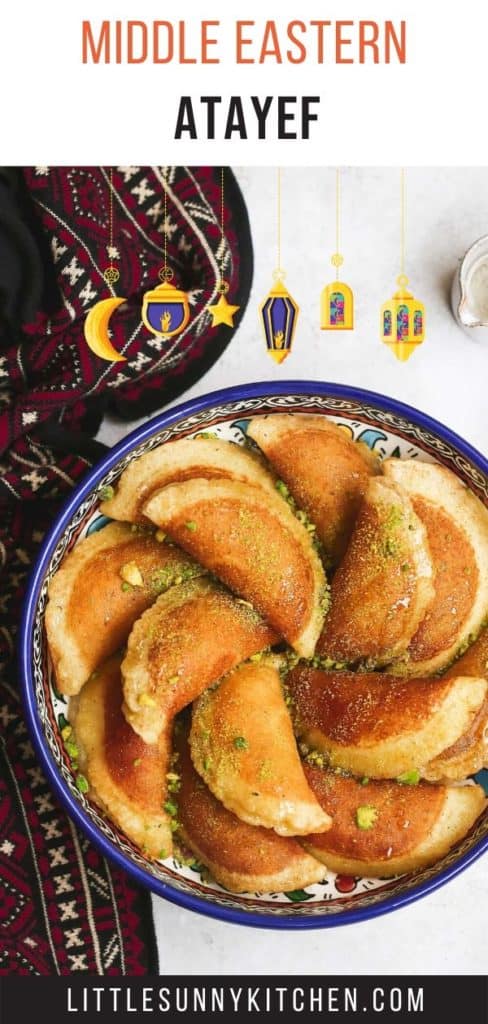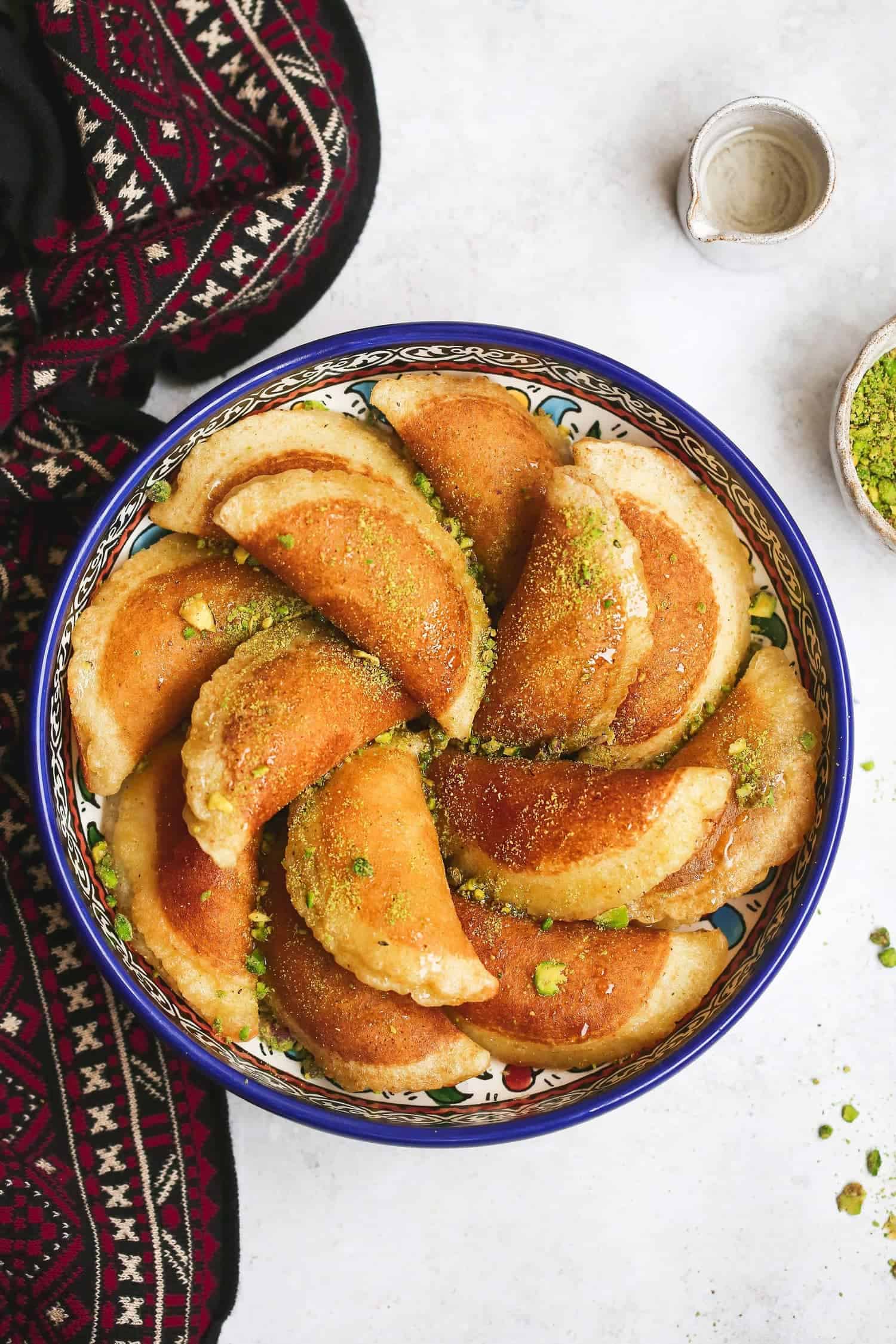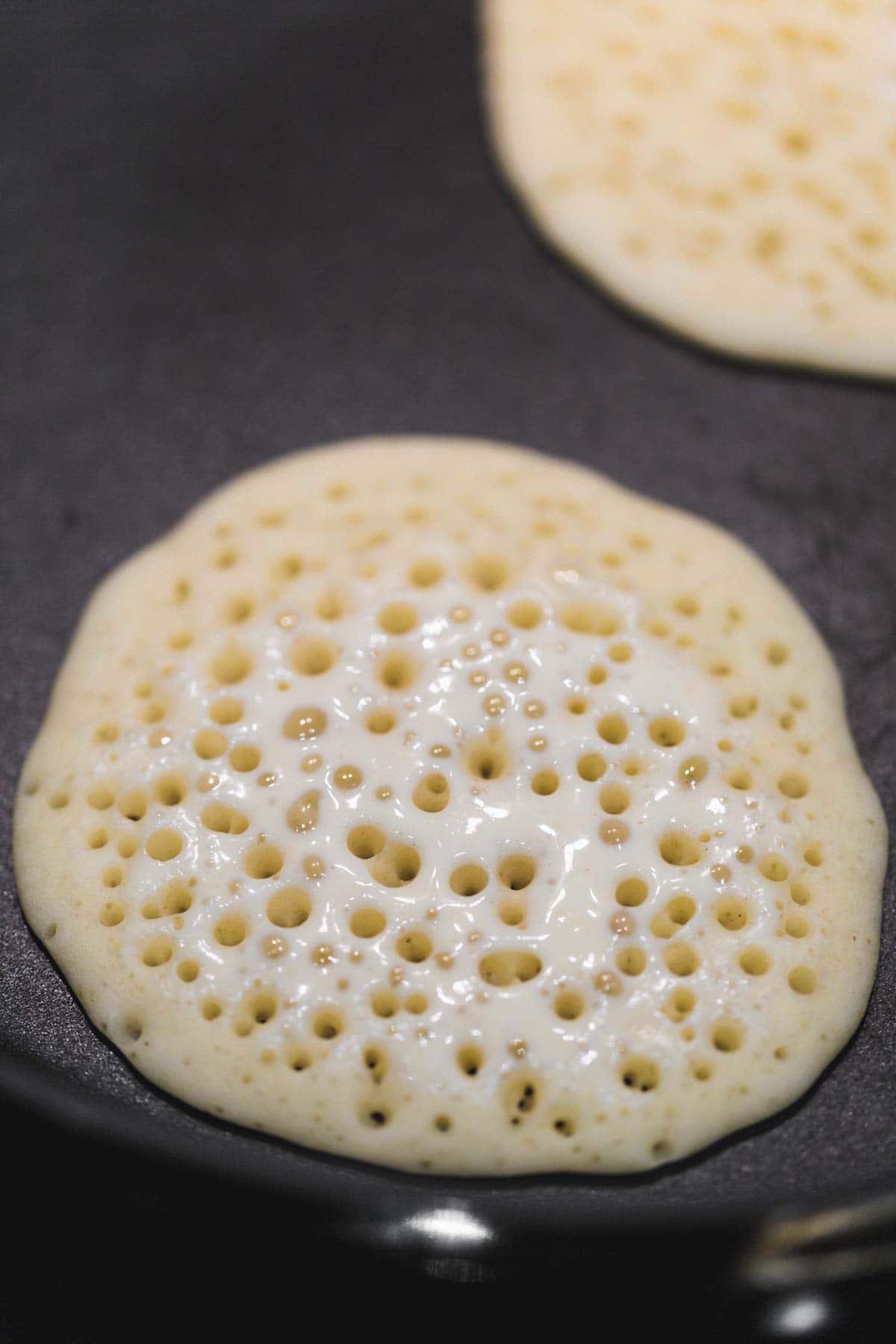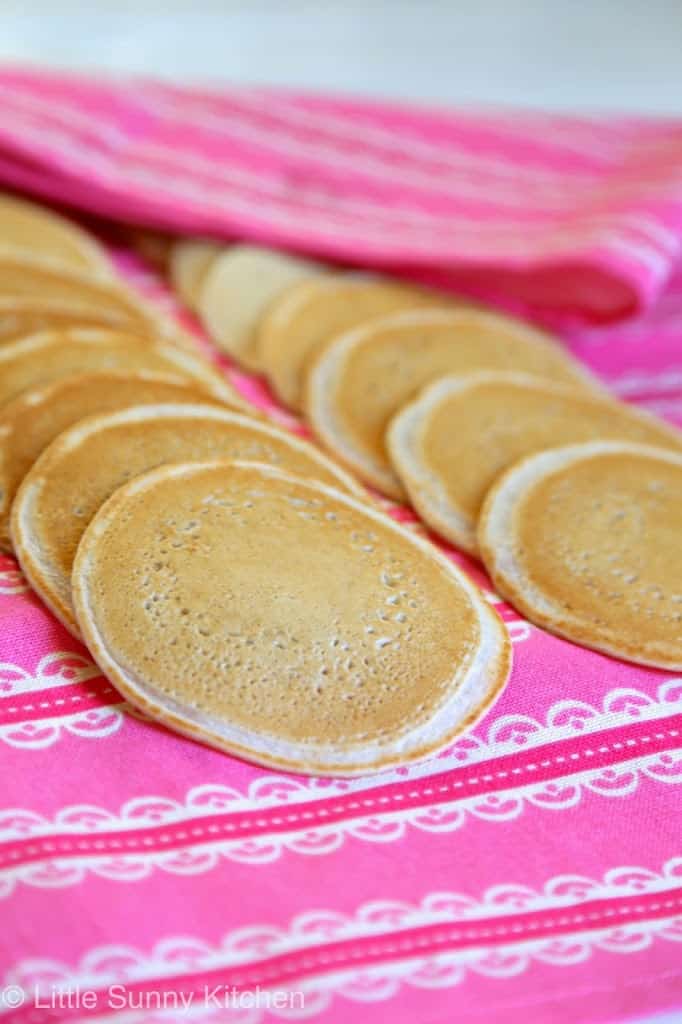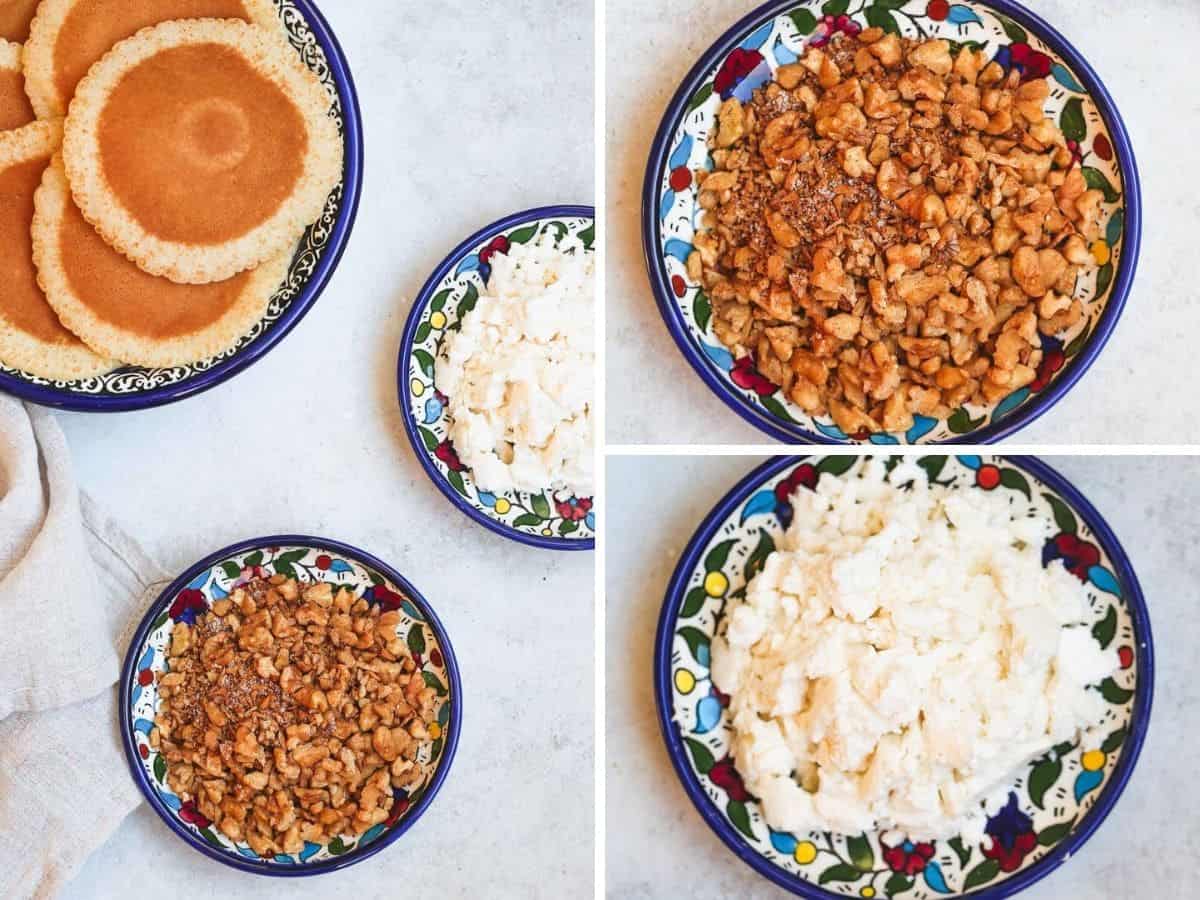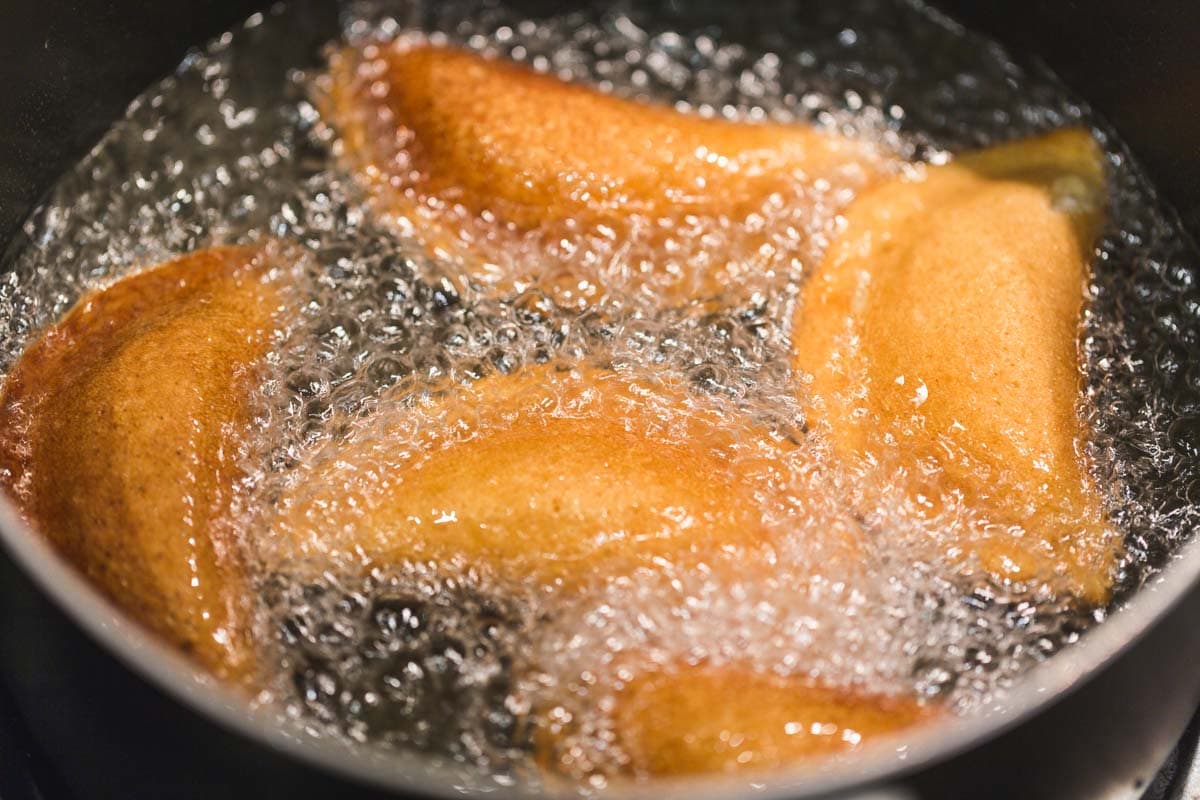Here’s a detailed recipe to make Atayef from scratch.
What are Atayef?
Once you try the Atayef – you will fall in love! I can guarantee you that! They’re basically the Middle Eastern version of pancakes, and they’re stuffed with lots of tasty fillings. Atayef (Qatayef) are usually prepared by street vendors in the streets of Jordan, Palestine, Syria, Lebanon, Morocco, and Egypt. They are also sold in bakeries nowadays, and some people prepare them at home. They’re very popular, it’s like you you have no choice but to have Atayef during Ramadan!
How to make Atayef from scratch?
Atayef are very similar to pancakes, they’re made with flour, fine semolina, yeast, milk, baking powder, salt, and sugar. If desired, vanilla extract, rose water, or orange blossom water can also be added. They’re usually cooked on a nonstick pan or a griddle pan with no oil, but only from one side (just like a British crumpet). They’re then folded, stuffed, cooked again (deep fried or baked), and finally drenched in simple syrup before they’re served. Atayef are just like pancakes, but they have two sides: one is lace-like (that’s where all the bubbles form), and the other is velvety smooth like a pancake.
Our Trip To A Local Bakery In Madaba, Jordan.
My Mom and I went to a local bakery in Madaba, Jordan, to see how traditional Atayef pancakes are made in bakeries nowadays. It was really interesting, as we got to see the technique and how the staff worked with great skill and speed. Below are some pictures for you to enjoy. We were very impressed by how efficient the staff was at making the Atayef. Not only were they super quick, but the size of all pancakes matched without using any special equipment. We were also shown how to make a giant Atayef, these are usually stuffed with Ashta (fresh cream) and nuts and are not folded. The filling goes on top of one pancake, then the filling comes, and it’s covered with another pancake. These are served immediately without frying or baking.
Types of Atayef
How to make Atayef
The technique is very important, it is very simple but make sure that you read the instructions carefully before you start. You may need 1/2 – 1/4 cup of water more or less in the recipe that I’m sharing with you as it depends on what kind of flour and semolina you’re using. The batter is sort of thin but the best way to know if you need to add more water or not is by making your first atayef pancake. If you get a fair amount of bubbles that means that your batter is perfect, if not, then you will need to add more water to the mixture. This is a common problem when it comes to making Atayef, working with a very thick batter.
In a medium-sized bowl, combine the dry ingredients (flour, semolina, sugar, and salt) and set aside. In a separate bowl, whisk together the wet ingredients (water, milk, and vanilla extract). Then add the dry ingredients to the wet ingredients and give everything a good whisk until well combined. A few lumps in the mixture are ok. Cover with a towel, and allow the batter to rest in a warm place for 20-30 minutes. Heat a non-stick pan or a griddle over medium-high heat, then pour the batter from a jug or using a spoon to create little circles (for small Atayef pour 1 tablespoon of batter, for medium-sized ones do 2 tablespoons, and ¼ cup for the large ones). The Atayef pancake will start bubbling, but make sure that you get a lot of bubbles because if you don’t, then your batter is way too thick. Each pancake should take about 1-2 minutes to cook, but that also depends on the size of the atayef that you’re making. When the last drop on the surface (bubbles) dries and isn’t shiny, that means that it’s done (remove from the pan immediately). Transfer to a tea towel and make sure that you fold down the towel to cover the pancakes, otherwise they will dry out really quickly (that can result in Atayef that are difficult to fold and seal when you want to fill them).
The atayef will become softer once they cool down, which is good because then they will be easier to fold and seal while you stuff them. If you don’t want to fill them right away, you can store them in an airtight container or a plastic bag to avoid drying, but I highly recommend that you stuff them and eat them on the same day.
Filling Suggestions
The most popular fillings for Atayef are “joz” which is cinnamon walnuts, and “jibneh” unsalted white cow’s cheese called Akkawi, which needs to be soaked in water so it’s no longer salty. If you can’t find white cheese, you can use ricotta with a little bit of sugar and rose water. Another less popular but delicious filling is Ashta cream, I have an excellent homemade Ashta recipe that you can make!
How to stuff the Atayef?
Atayef can be either fried or less commonly baked.
To fry: Heat vegetable, canola, or corn oil (about 1 inch) in a deep pan. Then, start dropping the stuffed Atayef and fry until the edges are slightly golden brown and crunchy. Remove from the hot oil, drain on a wire rack for a couple of minutes, and immediately soak them in the simple syrup for a few seconds (or drizzle them with it). To bake: Place the stuffed Atayef on a cookie sheet, and brush with vegetable oil. Bake in a preheated oven at 350°F/180°C for 10-15 minutes or until golden and crunchy. Drizzle with the simple syrup and serve.
© Little Sunny Kitchen
